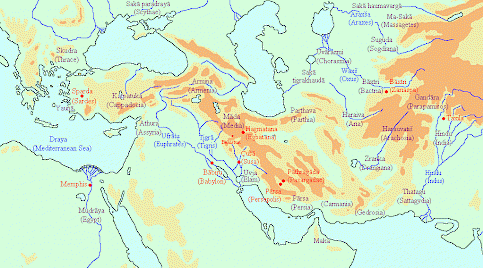Diadochi 4: The Second Diadoch War (East)
Diadochi ("successors"): name of the first generation of military and political leaders after the death of the Macedonian king and conqueror Alexander the Great in 323 BCE. To settle the question whether his empire should disintegrate or survive as a unity, and, if so, under whose rule, they fought several full-scale wars. The result, reached by 300, BCE, was a division into three large parts, which more or less coincided with Alexander's possessions in Europe, Asia, and Egypt.
During the next quarter of a century, it was decided whether these states could endure. As it turned out, there were no great territorial changes, although there were dynastic changes. After 280, the period of state-forming came to an end with three great states: Antigonid Macedonia, Ptolemaic Egypt, and the Seleucid kingdom in Asia.

In the spring of 318, the Second Diadoch War broke out. On one side, there was the lawful regent of the two Macedonian kings (Philip Arridaeus and Alexander IV), Polyperchon; on the other side, we find Cassander (the son of Polyperchon's predecessor Antipater), Ptolemy of Egypt, and the one-eyed supreme commander of the Macedonian forces in Asia, Antigonus Monophthalmus. In the preceding article, we have discussed the war in Europe, where Polyperchon was repelled by Cassander in 317. In the present article, we will discuss the war in Asia and the rise of Antigonus.
His main enemy was Eumenes, the former satrap of Cappadocia, who had once sided with the first regent of the kings, Perdiccas. Although Perdiccas had been defeated in the First Diadoch War (320), Eumenes had been able to withstand earlier attacks by Antigonus. But at the beginning of the Second War, Eumenes was besieged in a fortress named Nora in the western Taurus Mountains (text), and Antigonus had almost defeated him. However, the war against Polyperchon was more important, and the siege was lifted. Antigonus conquered Lydia and defeated Polyperchon's navy in the Autumn of 318.
Now, he regretted that he had allowed Eumenes to make his escape. He had sided with Polyperchon, had built an army, and had spent the summer in Phoenicia, building a navy. When Antigonus approached, Eumenes was forced to abandon his plans, and started to march to the east. His main asset was that king Philips Arridaeus, serving as a puppet of Polyperchon, had appointed him as supreme commander of the Macedonian forces in Asia. However, when he arrived at Babylon, satrap Seleucus refused to accept his credentials, and attacked his army. Eumenes was forced to make his escape to Susa, the capital of Elam (Spring 317).
Here he met the satraps of the eastern provinces, which were technically still the subjects of Philip Arridaeus and were not deeply involved in the struggle between the king and his enemies. Together, the eastern satraps possessed a large army, because they had fought against one of them, Peithon of Media, who had tried to subdue his colleagues. Peithon had been defeated, but the victorious army had not been disbanded. Eumenes addressed the satraps, told them that they had to think of the unity of the Macedonian empire and its dynasty, which were defended by Polyperchon and Eumenes, but threatened by Ptolemy, Cassander, and Antigonus. After this speech, the satraps sided with Eumenes.
Soon, Antigonus arrived. He could corner Eumenes, but was unable to defeat him and retired to Media, where he wanted to give some rest to his soldiers (August; text). However, Eumenes pursued him. The two armies joined battle in he neighborhood of Isfahan, but the result was a stalemate.

In January 316, a second battle took place near Gabae in the Iranian desert. This time, one of Eumenes' satraps, Peucestas satrap of Persia, retreated from the battle line, and although Eumenes stood his ground for some time, he was ultimately defeated.
Antigonus and his son Demetrius, who won his spurs during this battle, wanted to spare Eumenes. After all, the cause for which he had been fighting, the Macedonian royal house, had in the meantime disappeared. But the officers in the victorious army insisted on the death of Eumenes, who was executed. This was the end of the Second Diadoch War. From now on, Antigonus was the undisputed master of Asia.
He behaved accordingly. He seized royal property; lured Peithon of Media to his court, had him executed, and appointed Nicanor as satrap; he reorganized the eastern part of the empire (although he had to admit that the Indus valley was lost to the Indian king Chandragupta Maurya); he appointed new satraps; and when he returned to Babylonia, he treated his ally Seleucus as a mere subject (spring 316).
Seleucus understood that Antigonus was striving for sole rule, and knew that this would be the end of his own ambitions. He therefore fled to Ptolemy in Egypt. The new satrap of Babylonia was another Peithon, the former satrap of the Indian satrapy of Gandara.